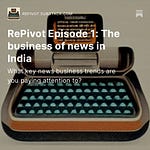By Jayant Sriram and Ramanathan S
On Episode 4 of the RePivot Podcast, a show focused on the business of news in India, Jayant Sriram and Ramanathan S speak to LV Navaneeth, CEO of THG Publishing Private Ltd, publishers of The Hindu, Business Line, Frontline, and Sportstar, among others. The Hindu is, of course, the jewel in the crown, and it has had an interesting trajectory in the last few years, emerging as a lighthouse example for reader revenue. To begin with, it was one of the first major publications to break the spiral of publishers competitively dropping the prices of print editions to sell more. The paper bet on the idea that readers would pay more for a quality product. Increasing the cover price of a print edition from Rs 2 to Rs 8 or 10 was still fairly revolutionary for the Indian market at the time, though things changed post-Covid, with many publishers following a path of higher cover prices. That initial faith in the willingness of readers to pay for news then set the foundation for The Hindu to launch a metered paywall for online access in October 2019, making it the first large national daily to take such a step.
Navaneeth returned to The Hindu group as CEO in June of that year and has since had a ringside view of the challenges involved with launching and running a subscription business model in the crowded Indian news landscape, and the underlying organisational transformation required to make it work. Navaneeth previously worked at The Hindu between 1998 and 2006 in a senior position in advertising and marketing. He was well placed to see how the publication, and the media business, had evolved over the years. In this episode our conversation with him covers these aspects:
What are the challenges of balancing between the ‘physical’ business (read: print circulation) and the digital business? This is a fascinating conundrum and perhaps the biggest management challenge for legacy publishers like The Hindu. Print advertising still brings in the lion’s share of revenue and for the most part, editorial operations are still centred around bringing out the print product. On the other hand, the digital business may be smaller in comparison for now, but it represents the future of growth for the industry, especially as print circulation volumes plateau or decline.
How important is the concept of editorial curation when approaching and planning a digital news offering? Unlike the physical newspaper, digital products like websites do not have a finite start and end and this affects the way readers interact with them. The Hindu has found a lot of success with subscriptions to its ‘e-paper’, (the digital replica of the print edition) which falls somewhere in between. Does that hold a lesson for how to organise content on the website, following a less-is more approach rather than volume and scale?
Four years on from launching a digital paywall and a subscription model, what are the lessons that The Hindu has learned, and what could have been done differently? Navaneeth shares insights on how priorities shifted from a singular focus on ‘acquisition’ of subscribers in the early days to ‘retention’. The main challenge in any subscription business is to continually engage with readers who buy a digital subscription and ensure they renew. The question of finding a balance between acquisition and retention in a digital business model is a foundational challenge for all news publishers today.
For THG’s larger stable of publications, including Business Line, Frontline and Sportstar, Navaneeth explains the progress with introducing a subscription model for each publication. A general news publication like The Hindu has its own challenges from a user’s standpoint, but how does this work for more niche offerings like a business paper and magazines?
And finally, a newly introduced rapid fire round with our guest! Amongst other things, we push Navaneeth on whether he thinks print will live on forever in India. The answer might surprise you..
Listen to the episode for more insights into The Hindu’s digital subscriptions journey.
SHOW NOTES
Programmatic advertising is an automated advertising process in which ads are purchased and dynamically placed on websites or apps. Programmatic advertising makes it possible to purchase and place ads, including targeted advertising content, at a fast pace. Most ads on the internet today are programmatic ads, and because of intermediaries like Google, programmatic ads contribute very little revenue to publishers.
Direct ads are ads which are sold directly by a publisher, and while the term is technically format-neutral, it is usually used to refer to display/banner ads which are sold directly.













